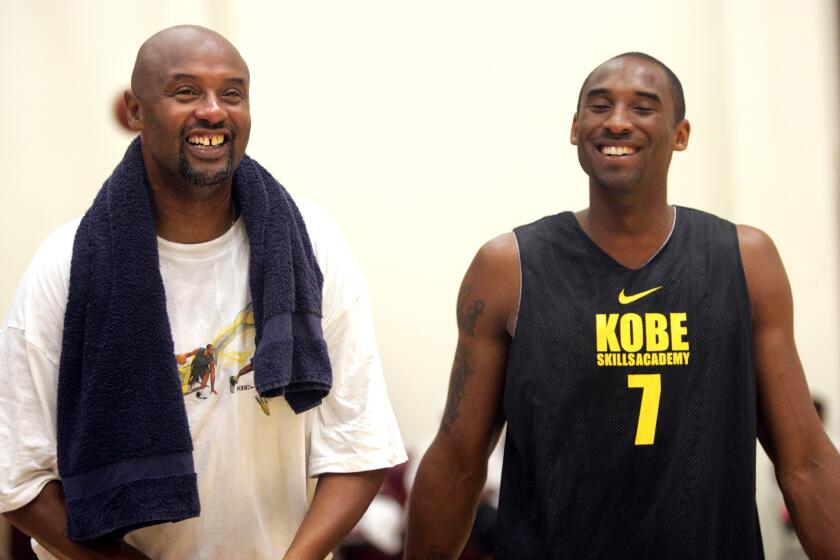Navy Pilot Blazes Trail for Other Women Fliers to Follow
Cmdr. Rosemary Mariner hails from the “first-or-never” generation of female aviators in the Navy.
When the 37-year-old set out to be a pilot, she says, the choice was simple: since the ranks of Navy aviators included no women, she could either be among the first, or never fly at all. She chose to be a pioneer.
She was one of the first eight women selected to attend flight school. She was the first woman to fly a tactical jet and to fly a front-line attack plane. And now, Mariner, who once washed planes in exchange for the chance to fly in one, is about to become the first woman to command a Navy aviation squadron.
“When I hit a wall, I am going to get under it, over it, or around it. Put a wall in front of me and my reaction is to knock it down,” said Mariner, explaining her ascent through the predominantly male world of the Navy.
Though federal law prohibits women from fighting in a war, Mariner and other women over the years have wrested--almost plane by plane--the right to fly high-performance planes, to go to sea, and to practice aircraft carrier landings.
“I definitely call myself a feminist--though I don’t agree with everything feminists do,” Mariner told The Times in her first interview since being named to her new position. “It’s very important for professional women to acknowledge that a lot of things would not have changed if not for bra-burners.”
Seated in her sparsely-furnished office, where a framed photo of her husband is the only visible personal memento, Mariner talked about her military career and contemplated what the future holds for enlisted women. More optimistic than many of her male counterparts, she predicted that women will be allowed in combat by the end of the decade. To Mariner, the deal is as good as done.
“It’s no longer an issue--it’s going to happen as a result of the demographics. The choice will be either drafting males or accepting females.”
Others, however, are less sure. “I don’t see it changing tomorrow or the next day,” said Vice Admiral Jeremy Boorda, chief of naval personnel and deputy chief of naval operations in Washington, D.C.
Today, women are 10% of the Navy’s force, up from about 2% in 1972. Among aviators, however, a woman pilot is still an anomaly. The Navy has 233 female pilots, which is less than 2% of its aviators.
On July 12, Mariner will assume command of the Tactical Electronic Warfare Squadron Thirty Four (VAQ-34) based at the Naval Air Station in Point Mugu. She is now the squadron’s executive officer, or second in command. The 300-member squadron, which is about 30% female and shore-based, provides simulated hostile electronic warfare for Atlantic and Pacific Fleet training exercises.
Why have a woman in charge of a squadron if she cannot lead that squadron into combat? “I am trying to make it as equal as it can be under an unequal situation,” said Boorda, who explained that women play an important part in training personnel for combat, even though they can’t fight themselves. “Those (women) are doing a job they can do whether the country is at peace or at war.”
Members of Mariner’s squadron say she’s doing her job better than most.
“Mariner has all the attributes and qualities of a good leader and a good fighter pilot. She has punched all the right tickets,” said Senior Chief Petty Officer Bob Howard, a Navy spokesman with the Pacific Fleet’s naval air force. “The fact that she is a woman has nothing to do with it.”
“I had not met a leader, a person whose qualities I want to emulate, until I got here,” said Lt. Sally Fountain, a Virginia native who joined the Navy five years ago and is now a member of Mariner’s squadron. “And as a female, when I find another woman, I sit up and take notice because she has done it. And she has done it right. That’s how I want to do it.”
For Fountain and others, Mariner is a role model--something that Mariner herself did not have as a young female pilot.
“Mariner is a point woman, the person who goes first and into harm’s way,” said Linda Grant De Pauw, professor of history at George Washington University and publisher of Minerva, a journal covering women in the military. “The image of woman as warrior is the flip side of woman as victim and women are so used to thinking of themselves as victims. Mariner and others are crucial as role models to young military women and to civilian women.”
Mariner, a 5-foot-3 blonde, dresses in the female Naval officer’s standard fare--beige skirt and short-sleeved shirt--when she is not flying. With her shoulders slightly rounded, Mariner, whose call sign is Saber, marches in standard-issue brown high heels through her offices at Point Mugu in Oxnard.
After 18 years, Mariner is a Navy devotee. She makes the A-7 attack plane sound like an old friend. And with the rhapsody of a ballet aficionado watching Swan Lake, she describes a sunset training bombing mission where four planes rolled at 120 degree angles in formation.
“If I could do it over again, I’d do it the same way. And that’s a good thing to be able to say after 18 years in the business.” But reconsidering, she added: “I might work harder.”
Mariner is not the only woman to ascend. Cmdr. Deborah Gernes has been named to command a Pearl Harbor-based fleet oiler, the Cimarron. And Lt. Cmdr. Darlene Iskra has been selected to command the Atlantic Fleet’s salvage ship Opportune beginning late this year.
And the Navy has already chosen the woman who will follow Mariner’s lead. Cmdr. Linda Hutton is scheduled to become the commanding officer of a Norfolk-based aviation squadron in April 1992.
Mariner sees these promotions--and her own--as part of the inevitable rise of women who will gain increasing responsibility and authority in the Navy.
Mariner had wanted to become a pilot since she was a child. Her father, an Air Force pilot, died in a plane crash when she was three. After his death, Mariner’s fascination with planes grew.
When Constance Merims, Mariner’s mother, moved her three daughters to San Diego in 1961, Rosemary was eight. But the young girl quickly discovered Miramar Naval Air Station. And soon, when she was asked to baby-sit her younger sisters, she would trot them through San Clemente Canyon to watch the jets take off at Miramar. Twice the girls watched as pilots ejected as their planes crashed, but Rosemary was determined to fly.
And her mother did not squash that dream.
“I was worried because her father had been killed in an aircraft accident but she was so determined to do it, I felt I shouldn’t hold her back,” said Merims, now a resident of the Clairemont neighborhood of San Diego and a former Navy nurse.
With single-minded determination, young Rosemary read every book on pilots and flying that she could get her hands on. And realizing that flying lessons would be costly, she began cleaning houses as a young teen-ager--keeping her earnings in a shoe box.
One afternoon, as she got ready to go clean a house, Rosemary turned on the television. An announcer interrupted the movie and said the network would call one member in the audience to ask the name of the film. When Rosemary’s phone rang, she knew the name of the movie--Interlude--and she won $200. The money was enough to launch her flying career. And Rosemary soon became a regular at Gillespie and Lindbergh Fields, where she washed planes in exchange for flight time.
At age 17, Rosemary Mariner earned her pilot’s license and caught a glimmer of the publicity that has dogged each milestone in her career. The San Diego papers described her as a sort of airborne wonder girl. Mariner graduated Patrick Henry High school and went off to college.
At Purdue University, the vice president of Trans World Airlines came to talk to Mariner’s class. When she inquired about becoming an airline pilot, she was told that the American public would never accept a woman aviator. Another airline official told her the same thing.
In that very year, 1973, the Navy decided to admit women to flight school. After getting a newspaper clipping from her mother that announced the Navy’s decision, Mariner applied. And she was accepted. Again, she endured another media blitz. Asked by a San Diego reporter if she wanted to become an astronaut, Mariner responded that she would be happy to go to the moon.
“I took it for granted that doors would be opening,” said Mariner. “And I wanted to be there when the doors opened. It wasn’t until much later that I realized it wasn’t going to be easy.”
In fact, from the beginning, it wasn’t at all easy. In the 19-week officer training school in Newport, Rhode Island, the women had classes in a separate facility from their male counterparts. The lessons often set Mariner’s teeth on edge. She learned, for instance, that it was undignified for female officers to sit atop bar stools, she said.
“I hated it. I was young and hot-headed,” Mariner said. “Nothing I was taught applied to the real Navy. What they were dealing with was a woman’s Navy and that is not the real Navy.”
Today, young Navy women scarcely sail an easy course, Mariner said. But it is far smoother than Mariner’s tumultuous times when she says some instructors told her they would do their best to see that she failed. Even so, she says those male colleagues interested in helping her succeed far outnumbered those “dinosaurs” who tried to thwart her. And when she talks of young enlistees, her voice becomes wistful.
“Sometimes I am very envious of the women starting out. But I am also envious of the young men--everything is possible when you are 22 years old,” said Mariner, who has logged more than 3,300 military flight hours in 15 different aircraft. “It’s great to be young and starting out.”
Dramatic progress has been made for women since Mariner joined the Navy, when most women assumed clerical or hospital-related jobs, said Lt. Cmdr. Dick Arnold, deputy special assistant for women’s policy in Washington. In 1987, a loosening of the definition of combat mission opened 26 ships, oilers and storage vessels, to women--opening 5,000 additional sea-bound jobs to female Navy recruits. Of the 70 Navy job classifications in 1972, women were allowed to hold 22. This year they can hold 88 of 102. Female aviators can be assigned to 51 of the 224 aviation squadrons.
While women are prohibited from fighting, they are allowed to participate in training exercises at sea aboard vessels on peaceful missions. Their seaward stints, however, are limited to no more than 180 days, while their male counterparts are often at sea for six months.
Despite these basic differences in training, Mariner insists that women must pursue the same prizes as their male counterparts.
“It’s important when you join the military that you understand the value system, that you shoot to be a commanding officer, that you have the same goals, same standards as your male colleagues,” she said.
Married for ten years to a fellow officer and pilot, Cmdr. George Thomas Mariner Jr., Rosemary Mariner says they plan to have children. But she also hopes to command a ship one day. And having children will have to wait, she said.
“I am a firm believer that women can have it all,” she said.
And she is only slightly fearful that she would be a tough parent.
“If my daughter said she wanted to be a cheerleader, I’d have an unfair reaction,” Mariner said. “I’d probably prefer she be a football player.”
More to Read
Start your day right
Sign up for Essential California for news, features and recommendations from the L.A. Times and beyond in your inbox six days a week.
You may occasionally receive promotional content from the Los Angeles Times.






